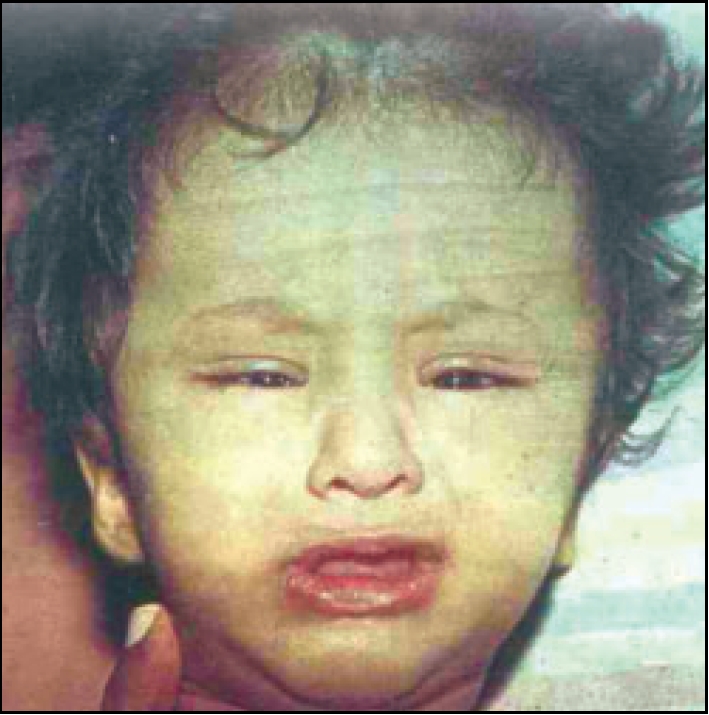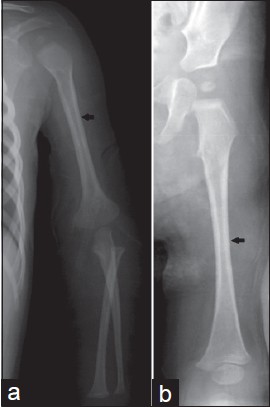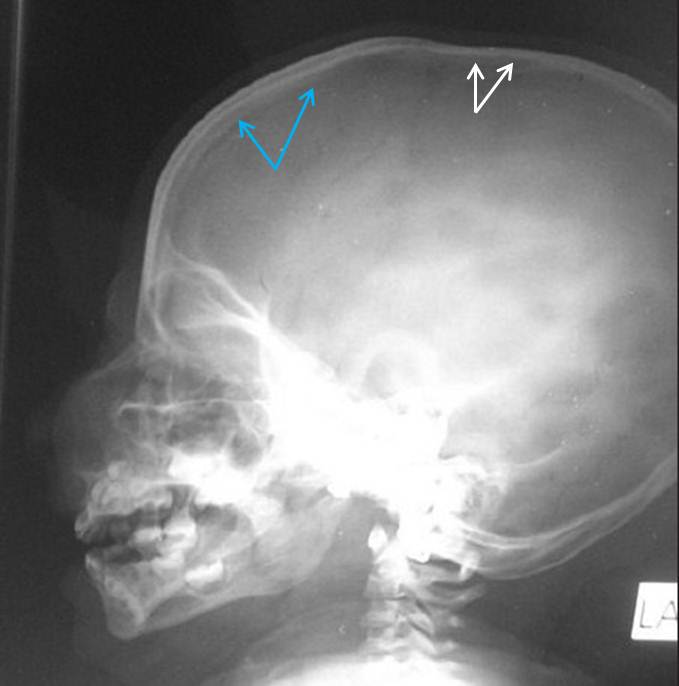Kenny-Caffey syndrome type 2; KCS2
Kenny-Caffey syndrome is an extremely rare skeletal disorder characterized by abnormalities in the long bones and the head. Less than 100 patients have been reported in the literature, and estimates for prevalence and incidence are not available.
Clinical information
One of the most noteworthy features of KCS2 is that the outer laters of long bones (the cortexes) are thicker than normal. This abnormality makes the marrow-containing cavities inside the bones too narrow (see photos below). Additionally, in the skull, a type of spongy bone called diploë is absent. The diploë lies between the hard outer bone of the skull and another harder bone inside the skull; this space is called the diploic space (see photo at bottom of page).
Another important problem that occurs in KCS is hypocalcemia (low blood calcium), which usually occurs at 2-3 months of age. Importantly, hypocalcemia in KCS2 is transient, meaning that its absence in a single test cannot rule out its occurence in general. In adults, it can be triggered by illness or stress. Low blood calcium can cause tetany, a condition that involves muscle twitches and spasms, cramps, and stridorous (high-pitched) breathing. Seizures can also occur in KCS. Intelligence is not usually affected, although it can be in a small minority of cases.
Many patients with KCS2 suffer from hypoparathyroidism, or low levels of parathyroid hormone. This hormone is important for regulating the levels of calcium and phosphorus in the blood. Patients experiencing hypoparathyroidism may feel tingling in their fingers, toes, or lips, and have muscle cramps and/or muscle spasms. They may also feel weak or nervous, have headaches, and/or memory loss. See the link at the right for more information about hypoparathyroidism.
Another form of Kenny-Caffey syndrome is sometimes called KCS type 1, but is more commonly called Sanjad Sakati syndrome (SSS). The two conditions share similar features, but are caused by mutations in different genes (see Differential Diagnosis, below). SSS also affects intelligence. To date, SSS has only been seen in people of Arab origin, while KCS has been seen in all ethnic groups.
The following are signs and symptoms of KCS:
- Premature ossification of the fontanels (soft spots turn bony too soon)
- Medullary stenosis of the long bones (see photos below)
- Absent diploic space in skull (see photo below)
- Farsightedness and/or nearsightedness
- Normal intelligence in most cases
- Short or very short stature
- Carious teeth (many cavities)
- Other dental abnormalities
- Macrocephaly (large head)
- Delayed bone age
- High blood phosphorus
- Low blood calcium
- Hypoparathyroidism
Common clinical features of KCS2
In addition, KCS2 patients often share a similar facial appearance (though facial similarities are not as striking as they are in many other syndromes):
- Small eyes (microphthalmia)
- Small jaw (micrognathia)
- Beaked or sharp nose
- Nasal abnormalities
- Facial assymetry
- Large forehead
- Deep-set eyes
Facial features in KCS2
KCS is an autosomal dominant disorder caused by mutations in the gene FAM111A. Autosomal dominant means that the syndrome can be passed from one affected parent to a child. KCS2 can also occur sporadically, when a mutation arises in the absence of a family history. The link at right provides information on labs that test for mutations in FAM111A. In addition, a diagnosis of KCS2 is also strongly indicated by skeletal x-ray studies showing thickening of long bone cortexes, along with very thin marrow cavities. Blood tests can detect low blood calcium.
The precise function of the gene FAM111A is not known. Hoever, it appears to have important roles in the production of parathyroid hormone, in calcium homeostasis, and skeletal development and growth (1).
The differential diagnosis for KCS2 includes KCS1, which is now seen as being the same disease as Sanjad Sakati syndrome/SSS. SSS is also called hypoparathyroidism-retardation-dysmorphism syndrome (HRD). Unlike KCS2, SSS is an autosomal recessive disorder, meaning that both parents must pass a mutated copy of a gene to a child. SSS is caused by mutations in the gene TBCE. KCS2 and SSS share hypoparathyroidism and abnormal levels of calcium/phosphate in the blood. Unlike KCS2 patients, Sanjad-Sakati patients have microcephaly (very small heads) and intellectual disabilities.
Other conditions that are similar to KCS2 include pycnodysostosis and osteopetrosis. Patients with pycnodysostosis are short the density of their bones in increased. The fontanels in these patients are also late in closing. Osteopetrosis patients have abnormally hard and thick bones. Again, symptoms include thickening of the bones, increased density of the bone marrow, delayed closure of the anterior fontanel. Unlike KCS2 patients, osteopetrosis patients may have anemia.
Hypoparathyroidism is a rare condition and is an important part of KCS2. It is advisable to look for skeletal signs of KCS2 in very short patient diagnosed with hypoparathyroidism.
References
- 1. Unger S et al. (2013) FAM111A mutations result in hypoparathyroidism and impaired skeletal development. Am J Hum Genet 92(6):990-995. Full text on Pubmed.
- 2. El Jabbour T et al. (2014) Kenny-Caffey syndrome type 1. Avicenna J Med 4(3):74-76. Full text on Pubmed.
- 3. Metwalley KA et al. (2012) Kenny-Caffey syndrome type 1 in an Egyptian girl. Indian J Endocrinol Metab 16(5):827-829. Full text on Pubmed.
- 4. Agarwal I et al. (2006) Kenny-Caffey syndrome. Indian J Hum Genet 12(2):96-98. Full text from publisher. Full text on ResearchGate.



